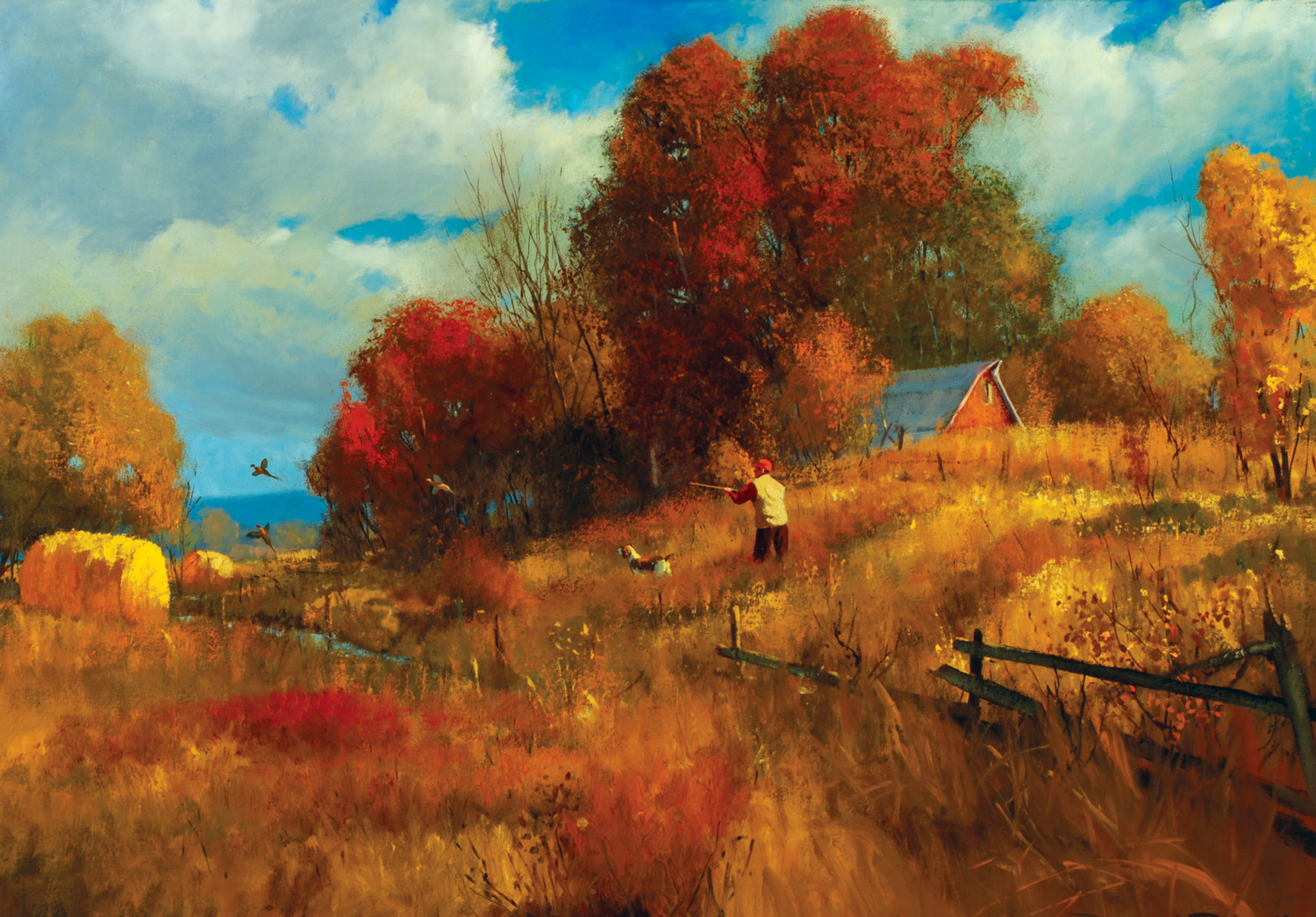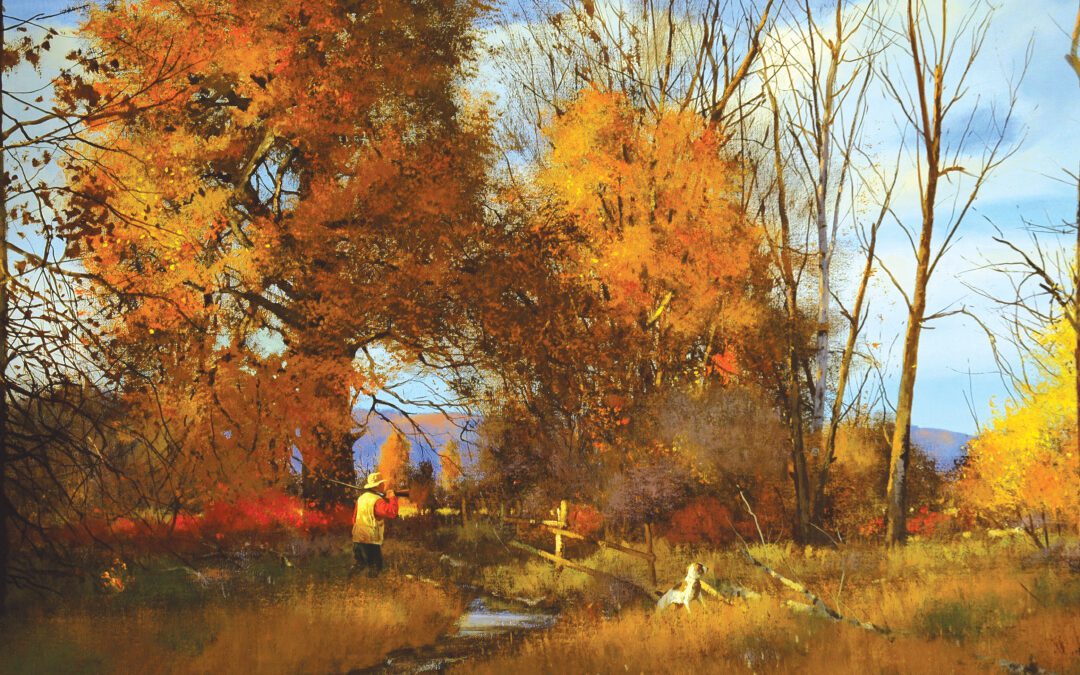The pheasants live along the little creeks and in the ragged notches of rimrock above and below the benches where there are miles of wheat stubble during the hunting season. The land goes upward in erratic stairsteps to Montana’s Crazy Mountains. And from a great distance there is little sign of the series of gullies, foothills, flats, and ranch homes between the main highways and the abrupt piles of the mountains themselves.
From the Yellowstone Valley the scene is compressed as if with a telephoto lens. On a hazy day the various levels are vaguely separated. But on bright days the distance shrinks, and it is hard to believe that a man once wrote a book about his life between the highway and the peaks, a busy life in which he lived in several different homes, rode miles of range, and had neighbors he seldom saw.
There is more than enough land against the Crazies for a small dog to hunt a lifetime and never meet the same pheasant twice. It really isn’t good pheasant country anyway and old Kelly hunted sharptail grouse, Hungarian partridge, and blue grouse there as well.
He hunted there every year of his life, although he lived far away in Florida, and he poked his orange-speckled nose into cover from Mexico to northern Alaska while I indulged in the probably childish project of shooting every major upland gamebird of North America over the same Brittany. Kelly must have wondered about that as he plunged off a cliff into an opaque Alaska fog to find a hard-hit ptarmigan, and when he was carried back into the truck in Arizona, helplessly fettered by unfamiliar cholla cactus.
Kelly’s furious drive kept me in constant introspection. After several days of hunting was it better to allow a limping, bloody-footed little warrior back into the field or was it better to shut him in the dog box where he wept so that my day was ruined as well as his?
Kelly had already pointed his North American list when Jack Ward and I went up under the mountain late in that pheasant season. It was sunny but there were patches of snow along the willowed creek that bordered that grain. He loafed in the back of the old Scout until we turned off the asphalt, and then he became a panting sentry, one window to another. He’d sighted a lot of birds from that old truck.
We went up the climbing gravel road that became narrower in a few miles, and we went through a wire gate we’d used for years and across the little creek where there were ruffed grouse sometimes and always darting little brook trout. We parked near the wheat field and while I dug out the snagged vest and the over-under with the bluing worn, I looked up at the Crazies, snowy now that late fall had really come, and looking no nearer than they had when we left the highway miles back.
“We’ll work down through these patches of cattails,” Jack said, and told of the big ranch dog that had smashed those cattails for him when he was much younger and lived under the mountains.
I released Kelly with the wince I always gave at his reckless, headlong charge for cover, and he went into the stand of cattails in a series of bounces, visible only at the top of his leaps. There were small, irregular patches of ice among the cattails, carrying old snow, and some of them showed pheasant tracks.

Brett Smith is acclaimed for his paintings of hunters in period settings, such as those halcyon days when Charley Waterman and Kelly coursed the continent’s gamefields. Above: Smith’s Autumn Wings.
Kelly made his living pointing things like quail, Huns, and ruffed grouse. Pheasant hunting was his hobby, a pursuit requiring a different approach part trailing, part pointing, part stealth, and even a bit of flushing. About pheasants Kelly had his own procedures, methods he’d researched and which were unrelated to the procedures of dog-training manuals. Follow Me!
We killed two birds that day and I remember little of the first gleaming cock except that I missed and Jack killed it. It was only a little later that Kelly was working another bird.
He was out of sight part of the time in the narrow jungle but could be seen with his eyes big and his nose flared in the open spots, so we knew the bird was running. The brindle detective went through more cattail patches and through the bank of wild rosebushes and between tight clumps of willows. We followed so far that we wondered if there were other birds to confuse the trail, and I began to look at the banks of the draw far ahead, for there have been times when worried old roosters have abandoned the tight cover to scurry, head down, up a gully’s shoulders to hide in little notches above where the hunter passes.
Then Kelly left the bottom and turned up the steep bank where the browning grass was almost knee deep. Apparently there had been too much for the cattle that year.
I hurried behind and to one side and he gave me conspiratorial glances of approval. He stopped and pointed, and when I reached his side he broke and went on at another angle. Finally he held, his head very high but turning slowly, and I stopped beside him, not knowing which direction to take.
Then, from some page of his pheasant-hunting notebook, Kelly drew one of his special tricks. He jumped high in the air three times right beside me, and Kelly’s last pheasant left from 20 feet away, startled by the orange and white explosion.
I have remembered the bird ever since as it has hung in the air, the mountain in the background, and the gun going up evenly. The bird came down hard, leaving a few feathers where it had been, but in my mind it hangs forever, climbing toward the Crazies with the muzzle coming up behind it. And while it goes I can see Kelly jumping straight up and down beside me, for the game is to make running pheasants fly.
It was an hour later that Kelly did not check in on time. I knew he had worked into a widened tangle farther down the little creek, so I went after him, using my whistle, and I saw him coming laboriously and dazed, a front shoulder smashed and the leg dragging. Finally, a reckless battle with some clump of vines or windfalls that had been too much.
I carried him to the truck and laid him on the ground to fix a bed for him in the back, and Kelly’s old friend Jack stood helplessly and took a long time to unload his gun. When I turned to lift the little dog into the truck, he had crawled several feet, his feverish eyes fixed upon a clump of brush a few yards away.
A good place for pheasants.
Weakened by his injury, old Kelly died before the next season began and we buried him under a modest sign that lists the birds he pointed. And once I dreamed on his brindle ghost hurrying along a hill in Alaska and through a Florida swamp, and then in brilliant relief across a ridge below the Crazies.
But the last pheasant is always there, hanging in suspended motion, with the benches, the distant pines, the streaks of yellow stubble, and the mountains in the background.
Note: Our thanks to Debie Waterman for allowing us to reprint this classic, originally published in Gray’s Sporting Journal

